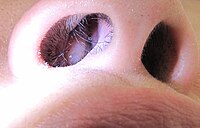
Photo from wikipedia
AIM To determine the clinically significant association between pneumatization types of the sphenoid sinus (SS) and protrusion/dehiscence of the optic nerve (ON) and the internal carotid artery (ICA). MATERIAL AND… Click to show full abstract
AIM To determine the clinically significant association between pneumatization types of the sphenoid sinus (SS) and protrusion/dehiscence of the optic nerve (ON) and the internal carotid artery (ICA). MATERIAL AND METHODS This prospective cross-sectional study was conducted between November 2020 and April 2021 at the Dow Institute of Radiology, Dow University of Health Sciences, Karachi. This study examined 300 computed tomography (CT) PNS patients aged 18-60 years. The forms of SS pneumatization, extent of pneumatization to the greater wing (GW), anterior clinoid process (ACP), and pterygoid process (PP), as well as the protrusion/dehiscence of the ON and ICA were examined. A statistical relationship was identified between pneumatization type and protrusion/dehiscence of the ON and ICA. RESULTS The study included 171 men and 129 women with an average age of 39.28±10.9 years. The most commonly encountered pneumatization type was postsellar (63.3%), followed by sellar (27.3%), presellar (8.7%), and conchal (0.75%). The most frequent extended pneumatization was observed up to PP (44%), followed by ACP (31.33%), and GW (16.67%). The rate of dehiscence of the ON and ICA was less than that of protrusion of the same structures. The association between postsellar and sellar pneumatization types and protrusion of the ON and ICA was statistically significant (p 0.001), with the postsellar type showing more protrusions of the ON and ICA than the sellar type. CONCLUSION The pneumatization type of SS has a significant impact on the protrusion/dehiscence of adjacent vital neurovascular structures and should be mentioned in CT reports to alert surgeons for any disastrous intraoperative complications and outcomes.
Journal Title: Turkish neurosurgery
Year Published: 2023
Link to full text (if available)
Share on Social Media: Sign Up to like & get
recommendations!